Plant Cells and Animal Cells Organelles Membrane Cell Structure and Function
- PDF
What educators are saying
Also included in
- This plant cells and animal cells bundle includes four fun and engaging tools for creating a memorable learning experience that your students will never forget! INCLUDED IN THIS BUNDLEPlant and Animal Cells Resource Unit Cell Model Project Cell Structure Cell Diagrams (FREE) Plant Cells and AnimalPrice $6.75Original Price $9.25Save $2.50
- Looking for a comprehensive collection of science lessons and activities that will engage and excite your third through fifth-grade students? Look no further than this GROWING elementary science units bundle!With a full year of lessons and activities, this bundle covers a range of topics, includingPrice $39.95Original Price $124.00Save $84.05
Description
Included you will find a wealth of plant cells and animal cells tools that will be a great addition to your life science resources. This cells unit packet contains a variety of ready to go activities, organizers, task cards, posters and more to supplement and enhance your instruction. In addition to the activities and organizers, you will also receive a variety of assessment tools to help you check for student understanding!
Included in this Science Packet
- 3 short Cells and Organelles Reading Passages
- Parts of a Cell Organizer
- Create an Organelle Activity
- 4 Important Words
- Cell Parts vs. Cell Needs Organizer
- Building Blocks of Life Web
- Cells Acrostic Poem
- Cells KWHL Organizer
- Specific Jobs
- I can Draw a Cell Activity
- Cells Doodle Page
- Plant Cell vs. Animal Cell Compare and Contrast
- Plant Cell Label the Digram
- Animal Cell Label the Diagram
- Plant vs. Animal Cell Information Table
- Plant vs. Animal Cell Fill-In Activity
- Cell Organelles Structure and Function Assessment
- 3 Pages of Plant and Animal Cell Organelle Organizers
- 4 Page Cell Organelle Assessment
- 20 Interactive Notebook Flip-Flaps
- 20 Cells Task Cards (color and b&w) with Student Answer Document
- 12 Colorful Cells Bulletin Board Posters
- 12 Word Wall Cards
- Answer Key
Let's Stay Connected
Click HERE to receive fun FREE classroom resources as well as classroom tips and fun teacher hacks from Tied 2 Teaching!
Questions or Comments?
We welcome all questions or comments! Please feel free to e-mail us at tied2teaching@gmail.com
I Love My Followers
Look for the green star at the top of the page next to my store logo. Click it to become a follower. When you do this, you’ll receive customized email updates about Tied 2 Teaching, and information about sales and new products!
Don't forget to leave feedback to earn points to use towards FREE TPT purchases!







